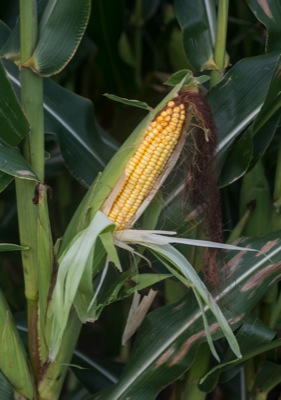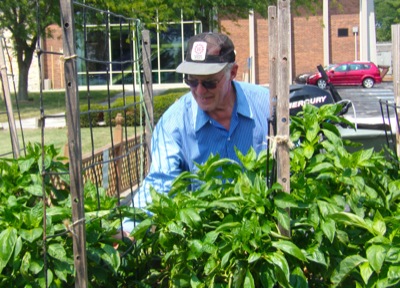Friday, August 22nd, 2014
Ag officials report corn, bean harvest outlook appears bright
Farmers, gardeners cope with cool weather
By Nancy Allen

Photo by Mark Pummell/The Daily Standard
Cooler temperatures this summer have helped create a good corn crop and helped keep down damaging diseases.
Area ag officials report very good to excellent soybean and corn stands this year despite earlier concerns that unseasonably cool temperatures would hurt crops.
In fact, cooler temperatures have helped corn in particular, they said.
"The cool nights we've had are good news, and moderate temperatures during the day are great news (for corn)," said Chris Gibbs, executive director of the Mercer County Farm Service Agency. "The cool weather also suppresses diseases."
Denny Riethman, Mercer County OSU Extension educator, agrees.
"With corn you are dealing with growing degree days and we are still within good parameters for that," he said. "But it's going to take longer for corn to dry down this year because there is plenty of moisture in the plant and kernels."
Soybeans have fared well in the cool weather as well, he added.
"It's not drastically affected them," Riethman said. "We are still within the required (optimal temperatures) to grow the crop."
The U.S. Department of Agriculture projects record corn and soybean harvests for Ohio and the nation as a whole this year. Ohio farmers are expected to near their 2013 output of both crops, which also was a record, USDA says.
The fair summer weather helped Ohio's corn and soybeans rebound since farmers had experienced a cold, wet spring that delayed planting for some and washed out spots in some fields.
Bumper crops don't mean big profits, though, at least not this year. Corn and soybean prices have plummeted as global markets anticipate the predicted U.S. bumper crops.
"The primary driver (of lower market prices) is the expectation of lots of bushels this fall," said Matt Roberts, an OSU agricultural economist. "The decline in prices means this year will not look anything like the past five to six years have from a profitability standpoint."
The last five or six years have been among the most profitable in history for the country's corn and soybean growers due to high market prices, he said.
Roberts said in April corn was selling for $5 per bushel for this year's harvest. Now it's about $3.50 based on the Ohio cash average for new crop corn. In April new crop soybeans were $12.50 per bushel and now they're $10.20, he said.
Fewer dollars in farmers' pockets also will translate into less spending at businesses that support agriculture, he said.
"We've already started to see this in some areas, like reduced spending on some equipment," Roberts said. "We expect this to accelerate in the coming year, as well as reduced spending on new land and less eagerness to pay top dollar for land and fewer new vehicles."
Roberts said farmers who have managed conservatively during the last few years should still be profitable this year but in a "very sort of ordinary sense."
"Those who have been very, very aggressive could be very, very unprofitable in 2015," he said.
Riethman said he was questioned by many people during the recent Mercer County Fair about whether cool temperatures would hurt the county's agricultural crops.
"In July and August there were a few mornings where you needed a sweatshirt, and that's kind of unusual," he said. "Because of that maybe people thought, 'Wow, I wonder how that's affecting the crops.' "
Mendon area farmer Jeff Johnson said his soybeans this year are the best he's raised in 25 years. He didn't plant corn this year.
"The last time I had a crop look this good was the early 1990s," Johnson said, adding that heavy rains did not delay his planting as it did for some farmers.
Johnson said he expects crop prices this year to be the lowest he's gotten in the last five or six years.
"The world surplus is increasing, so unless something drastic happens, it's a given that we're going to have lower prices," he said.
A local ag official cautioned that weather-related events such as high winds and early, hard frost could still affect local corn and soybeans.
"Normally I am doing storm and disaster reports this time of year, but knock on wood," said Anita Green, executive director of the Auglaize County FSA office. "At this point what we can hope is that Mother Nature continues to cooperate all the way through harvest."
Green said harvest will stretch out two to three weeks later this year due to spring rains that delayed planting.



